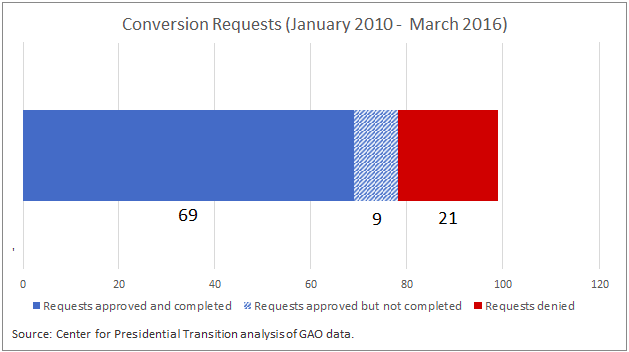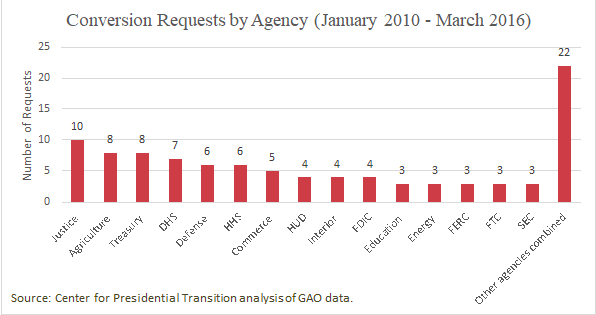Blog
October 14, 2020
Political Appointee To Civil Servant: What the Public Should Know About “Burrowing In”
By Alex Tippett and Troy Cribb
During election seasons, the status of political appointees in the federal workforce come under increased scrutiny. Under all recent presidents, some political appointees have attempted to become civil servants — a process commonly called “burrowing in.”
Unlike political appointments, civil service positions do not terminate at the end of an administration. Conversion therefore allows political appointees to stay in government after the president who appointed them has left office.
These kinds of conversions inevitably create concerns. Supporters of an incoming president may be suspicious of individuals hired by the previous administration. More broadly, some fear conversions can violate the merit system principles that govern hiring in the federal civil service.
The hiring process for civil servants is designed to promote a professional, apolitical workforce and to prevent discrimination, political favoritism, nepotism or other prohibited practices. To ensure these rules are followed, the Office of Personnel Management reviews requests to move a political appointee into the civil service. This review is designed to prevent improper conversions while providing talented individuals with the opportunity to join the civil service.
How does OPM conduct oversight?
While OPM has reviewed conversions since the Carter administration, the process has changed over time. Currently, agencies must submit a request to OPM whenever they seek to hire a current political appointee or one who has served in a political position within the last five years. OPM conducts multi-level reviews of each application to make sure the conversion follows federal hiring guidelines.
If OPM believes a conversion violates federal hiring laws or regulations, it may reject the conversion. If OPM finds the agency’s conversion attempt violates the federal government’s prohibited personnel practices, it may refer the issue to the Office of Special Counsel for investigation.
On occasion, agencies have converted political appointees without going through the OPM review process. In those cases, OPM retroactively reviews the conversions and issues any necessary corrective actions, which can include re-advertising the position. Recently, the U.S. Court of Appeals upheld the firing of an appointee who had converted to a career position without an OPM review.
OPM’s procedure is not laid out in statute. Instead, existing laws and regulations broadly empower OPM to protect the civil service’s merit system. Individual OPM directors have interpreted this authority differently, with the rules tightening over the years. Previously, agencies only had to file a request for a smaller subset of political appointees and only for conversions taking place close to an election. OPM’s current regulations require that every conversion receive approval.
Congress also created specific reporting requirements for conversions. The Edward “Ted” Kaufman and Michael Leavitt Presidential Transitions Improvements Act of 2015 requires that OPM submit an annual report to Congress detailing the conversions. During the final year of a presidential term, these reports must be submitted quarterly.
How common is burrowing?
Investigations by the Government Accountability Office suggest that conversions are relatively rare. According to GAO’s most recent report in 2017, OPM received 99 conversion requests from January 2010 to March 2016. For context, during that period, the federal government hired about 100,000 people every year into full-time permanent positions.
Of those 99 requests, OPM approved 78, suggesting that most conversions followed proper procedure. The GAO found no reason to disagree with OPM’s assessments.
Of the 78 requests approved by OPM in the latest GAO report, only 69 were carried out. Occasionally, an applicant will decline to take the job after it is offered to them.

A relatively small number of agencies have accounted for a large portion of conversion requests. Between January 2010 and March 2016, approximately 10% of requests were initiated by the Justice Department. The top five agencies—Justice, Treasury, Defense, Agriculture and Homeland Security—accounted for nearly 40% of the conversion requests filed.

Some agencies have occasionally failed to request permission from OPM before carrying out conversions. There were seven instances of this cited by the GAO. When this occurs, OPM carries out a post-appointment review as soon as it becomes aware of the conversion.
Conversions themselves also tend to increase immediately before an election. While available data is incomplete, 47 conversions occurred in the final year of President George W. Bush’s presidency, up from 36 the previous year. At least 19 occurred in President Barrack Obama’s fourth year, up from 11 the previous year. GAO’s 2017 burrowing report does not include the final months of Obama’s administration or the entirety of the Trump administration.
Additional public data would be helpful
While the law requires OPM to report instances of burrowing to Congress, neither the agency nor the House Committee on Oversight and Reform or the Senate Committee on Homeland Security and Governmental Affairs have made the information public. Doing so is in the public interest and could help guard against potential abuses.



